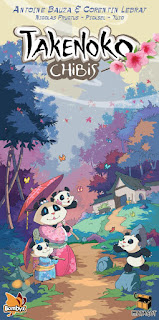Takenoko: 2 -4 players, 45 minutes, Ages 8+
Overview: By placing tiles, growing and eating bamboo, complete goal cards to score the most points. The player that can balance growing their species (red, yellow, green) of bamboo with the appetite of the hungry panda will win the game.
Child Playability: Symbol reading required. Language reading skills not required. Low number counts. Bamboo pieces are small enough to be eaten.
Game play: Starting with an irrigation tile in the middle of the play area, roll a "weather die" that tells you to "gain 1 action", "rain" on 1 tile, take two of the same action, move a panda, obtain a tile improvement token, or pick one of the above. Then you get two actions to draw and place a new tile, irrigate, move the gardener (to grow bamboo), move the panda (to eat bamboo), or draw a new goal card.
Review: This is a fairly simple and light family game that is great to play after a dinner party or with your kids. The components are cute and well made and the tiles are sturdy. The art is great and the game play is easy to learn. If you have friends (especially of the female variety) that are not into board games so much, this would be a great way to introduce them to the hobby. The mini goals that need to be met throughout the game keep you engaged and make you keep thinking about how to meet your next objective. The strategy is light but still enough to not bore the moderate gamers.
You can block other players or set them back by trying to accomplish your own goals which can frustrate children...but they need to learn sometime and why not do it with a cute panda bear eating their bamboo goals?
As a group game I find that it is great with 3-4 people that are looking for a light game. For a little more strategy and PVP action, a two player game is good as you really start to watch the other player's moves in an attempt to block their cards you think they have. Adding additional rules like discarding goals you already have completed or making incomplete goals count negative like in Ticket to Ride can add more stress for those looking to make it a more medium weight game.
Expansion: The expansion (Chibis) adds a female panda, babies (3 of each color), 6 new tiles and some new goal cards. The expansion adds a little more strategy to the game and a bit of luck as each of the babies give you a random bonus. Watching other players' bonuses from the babies can push you into trying to get certain ones if you know what is left as all 3 colors have the same 3 unique bonuses. The new tiles can make bamboo grow anywhere, one tile grow all three colors, and a new way to obtain goal cards. Chibis adds to the game without making it too complex and keeps it at a light - medium weight game that is still good for new gamers.
Recommended for: New gamers, Friends and family of gamers, Children.
Not recommended for: Moderate - Heavy gamers









